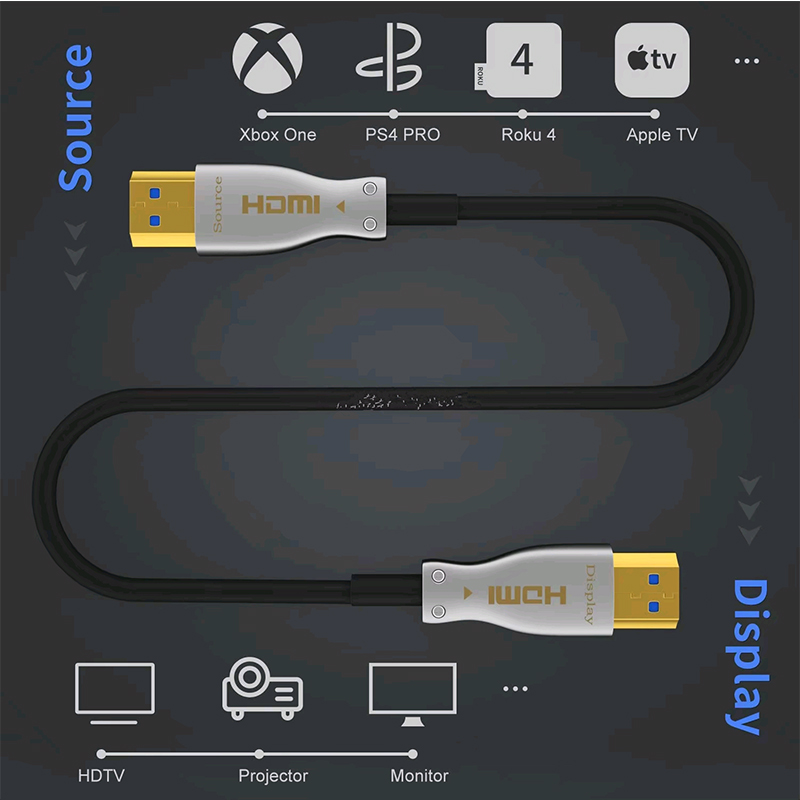The Rising Demand for 8K and the Need for Advanced Cable Solutions
As technology advances and 8K resolution becomes increasingly common, the demand for high-quality HDMI cables capable of supporting this ultra-high-definition content is at an all-time high. When it comes to transmitting 8K signals, choosing the right cable is crucial. As a trusted 8K AOC manufacturer, we understand the need for solutions that not only deliver superior signal quality but also offer long-term reliability.
In this article, we’ll compare 8k Fiber optic HDMI cable Manufacturer with traditional copper HDMI cables, analyzing their performance, flexibility, durability, and cost-effectiveness. This comparison will provide insights into why fiber optic cables are quickly becoming the preferred choice for demanding 8K applications.
Signal Transmission and Bandwidth: The Core of 8K Video Quality Copper HDMI Cables: Limited Bandwidth for 8K Content
Traditional copper HDMI cables have long been a reliable option for standard HDMI applications. However, when it comes to transmitting ultra-high-definition signals like 8K, copper cables show significant limitations. Copper HDMI cables are constrained by their ability to transmit large amounts of data over long distances without signal degradation. The bandwidth required for 8K video (up to 48Gbps) is beyond the capacity of standard copper cables, especially at longer lengths.
For a 8k Fiber optic HDMI cable Manufacturer, achieving flawless 8K video quality with copper cables often requires expensive and thicker cables, which still can’t match the capabilities of fiber optic alternatives. Signal loss, latency, and image artifacts are common issues when using copper HDMI cables for 8K setups, particularly when cables exceed 10-15 feet in length.
Fiber Optic HDMI Cables: Unmatched Bandwidth for 8K Video Transmission
In contrast, 8K fiber optic HDMI cables are designed to handle the immense bandwidth required for ultra-high-definition content. Fiber optics use light signals to transmit data, which allows them to support extremely high bandwidths (up to 100Gbps). As a leading 8k Fiber optic HDMI cable Manufacturer, we understand that fiber optic cables are ideal for transmitting 8K signals over long distances without significant loss in signal quality. Even at lengths exceeding 50 feet, fiber optic cables can maintain pristine 8K resolution, ensuring that the content remains sharp, vivid, and distortion-free.
Fiber optic HDMI cables not only provide the necessary bandwidth for 8K but also future-proof your setup, allowing for easier upgrades as video resolutions continue to rise.
Flexibility and Length: Copper vs. Fiber Optic Performance Copper HDMI Cables: Limited Flexibility and Shorter Lengths
Copper HDMI cables are generally stiff and less flexible, which makes them more difficult to install in tight spaces or around corners. The lack of flexibility can be a significant issue in complex installations, such as in professional broadcasting environments or large-scale commercial setups. Additionally, copper cables are limited in terms of length. When you need to run a cable longer than 10-15 feet, you risk signal degradation, especially when handling high-bandwidth 8K content.
Fiber Optic HDMI Cables: Flexibility and Longer Cable Runs
One of the greatest advantages of fiber optic HDMI cables is their flexibility. Fiber optic cables are lighter, thinner, and more flexible than copper cables, making them easier to install in challenging environments. As a best 8K AOC manufacturer, we understand the importance of easy installation. Fiber optic cables can be routed through narrow spaces and around corners without loss of performance.
Moreover, fiber optic HDMI cables excel in supporting long cable runs. While copper cables degrade over long distances, fiber optic cables maintain their performance over significantly longer lengths—up to 100 feet or more. This makes them the preferred choice for large venues, professional video production setups, and home theater installations where long-distance transmission is essential.
Signal Integrity and Interference Resistance Copper HDMI Cables: Susceptible to EMI and Signal Degradation
Traditional copper HDMI cables are vulnerable to electromagnetic interference (EMI) and radio frequency interference (RFI), especially in environments with high electrical activity. These interferences can cause signal degradation, resulting in picture and sound distortions. As video resolutions increase, the risk of interference also rises, which can result in poor 8K video quality.
Fiber Optic HDMI Cables: Immune to EMI and RFI
In contrast, 8K fiber optic HDMI cables are immune to EMI and RFI due to the nature of their signal transmission. Since fiber optic cables use light signals rather than electrical signals, they are not affected by electrical noise. This makes fiber optic HDMI cables ideal for environments where high-quality signal transmission is essential, such as in studio settings, professional AV installations, and large digital signage networks.
By using fiber optics, you can ensure that your 8K signals remain clear, crisp, and interference-free, even in electrically noisy environments.
Signal Integrity and Interference Resistance Copper HDMI Cables: Susceptible to EMI and Signal Degradation
Traditional copper HDMI cables are vulnerable to electromagnetic interference (EMI) and radio frequency interference (RFI), especially in environments with high electrical activity. These interferences can cause signal degradation, resulting in picture and sound distortions. As video resolutions increase, the risk of interference also rises, which can result in poor 8K video quality.
Fiber Optic HDMI Cables: Immune to EMI and RFI
In contrast, 8K fiber optic HDMI cables are immune to EMI and RFI due to the nature of their signal transmission. Since fiber optic cables use light signals rather than electrical signals, they are not affected by electrical noise. This makes fiber optic HDMI cables ideal for environments where high-quality signal transmission is essential, such as in studio settings, professional AV installations, and large digital signage networks.
By using fiber optics, you can ensure that your 8K signals remain clear, crisp, and interference-free, even in electrically noisy environments.
Cost Consideration: Short-Term vs. Long-Term Value
Copper HDMI Cables: Affordable but Limited in 8K Applications
Copper HDMI cables are generally more affordable upfront compared to fiber optic cables. This lower initial cost makes them an attractive option for consumers on a budget or those using standard HDMI resolutions. However, when it comes to 8K video, copper cables become less cost-effective. As 8K video requires higher bandwidth, copper cables must be upgraded to higher-end, thicker versions, which can drive up costs significantly, especially for long-distance transmission.
Fiber Optic HDMI Cables: Higher Initial Cost, Long-Term Benefits
While fiber optic HDMI cables tend to be more expensive initially, their long-term benefits far outweigh the upfront investment. Fiber optic cables are built to handle higher resolutions like 8K, ensuring that you won’t need to upgrade your cables as frequently. Additionally, the durability, flexibility, and long-distance performance of fiber optics result in fewer replacements and lower maintenance costs over time. For businesses or professionals seeking reliable and future-proof solutions, fiber optics are a more cost-effective investment in the long run.
خاتمة
Which Cable is Right for Your 8K Setup?
In conclusion, while copper HDMI cables may be suitable for lower-resolution video transmission, they fall short when it comes to meeting the demands of 8K content. The higher bandwidth, greater flexibility, superior signal integrity, and long-term durability of 8K fiber optic HDMI cables make them the superior choice for demanding applications.
As a best 8K AOC manufacturer, we are committed to providing high-quality fiber optic HDMI cables that meet the rigorous standards required for 8K video transmission. Whether you’re upgrading your home theater system, setting up a professional video production studio, or deploying a commercial AV network, fiber optic HDMI cables are the best option for delivering flawless 8K video quality.
Choosing the right HDMI cable is essential for maximizing the potential of your 8K content, and fiber optic cables offer the ideal solution for those looking for performance, reliability, and future-proofing in their AV setup.

